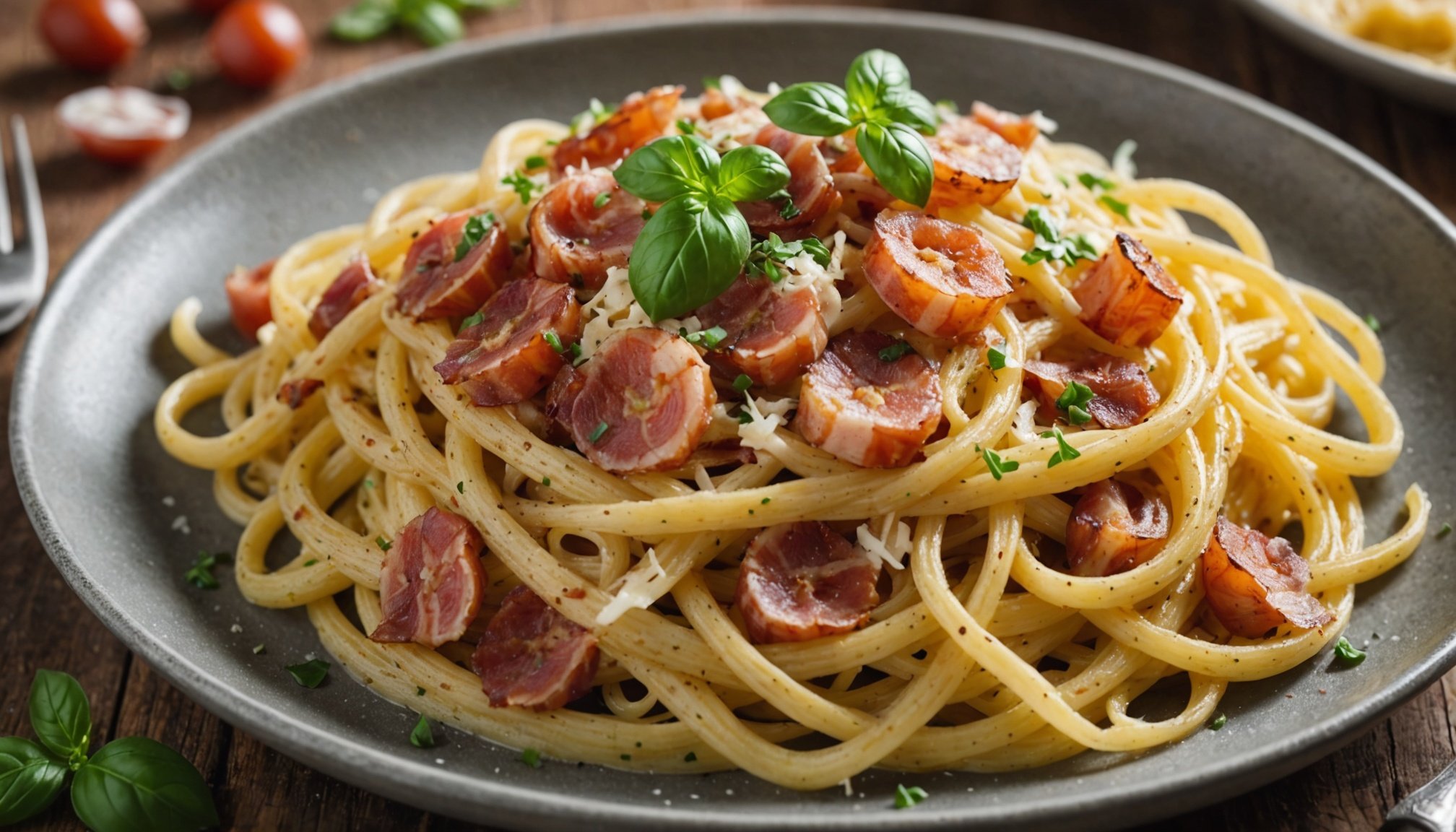Understanding the Essentials of Carbonara
Italian cuisine is celebrated for its simplicity, with Carbonara being a beloved classic. Achieving an authentic flavor profile begins with selecting the right Carbonara ingredients. The essentials include eggs, pecorino cheese, black pepper, and pasta, but the presence of crispy pancetta—not bacon—is crucial. This Italian specialty contributes both flavor and texture, elevating the entire dish.
The preparation method significantly impacts the outcome of your Carbonara. Traditional methods dictate combining fresh eggs with hot pasta to create a creamy sauce, an approach that emphasizes the natural flavors and textures of the Italian cuisine basics. However, modern variations often incorporate cream, altering the dish’s essence and richness.
Topic to read : Master Chef Secrets: Cooking Techniques to Guarantee Culinary Success
Crafting authentic Carbonara also requires respect for cooking techniques. Use medium-low heat to render pancetta fat slowly, creating a crisp texture without burning. This technique enhances the pancetta’s savory depth, marrying perfectly with the cheese and egg mixture. No matter the variations explored, maintaining the fundamentals will ensure a delicious outcome while staying true to its roots. Embrace the heritage and enjoy the delightful symphony of delightful Italian cuisine basics in every bite.
Step-by-Step Recipe for Perfect Italian Carbonara
Creating the perfect Carbonara requires precision and care. Begin by gathering the essential Carbonara ingredients: 100g pancetta, 50g pecorino cheese, 50g parmesan, 3 large eggs, 350g spaghetti, and fresh black pepper. These measurements are ideal for four servings, ensuring each plate is rich in authentic flavor profiles.
Also read : Essential Culinary Delights for Sustainable Development: A Must-Taste Guide
Start by cooking the spaghetti in a large pot of boiling salted water until al dente. For crisp pancetta, cut into lardons and gently fry in a pan over medium heat. This renders the fat, adding a savory character to the dish. While spaghetti cooks, beat together the eggs and cheeses, seasoning with pepper to your taste.
Once the spaghetti is ready, drain it, then transfer to the pan with pancetta, combining over low heat. Timing is crucial as you add the egg mixture. Quickly toss the pasta to coat it evenly without scrambling the eggs. The residual heat from the spaghetti transforms the ingredients into a creamy sauce, capturing the true essence of Carbonara.
Visual aids could enhance your understanding of each step, ensuring each participant can replicate this iconic dish flawlessly.
Achieving the Perfect Creamy Sauce
Creating a creamy carbonara sauce begins with mastering the delicate balance of temperature and timing with your eggs. Ensure your eggs are at room temperature before incorporating them into the pasta. This simple step can be pivotal in avoiding a scrambled consistency.
The sauce’s creaminess hinges on egg emulsification, which smoothly blends the eggs with the hot pasta and rendered pancetta fat. Swiftly tossing the mixture allows the residual heat to gently cook the eggs, forming a velvety sauce without using cream. This technique remains true to Italian cuisine basics by showcasing the dish’s inherent flavours.
When aiming for this authentic texture, avoid high heat, which can cause the sauce to curdle or separate. Instead, maintain a gentle, steady temperature. Trial and error, practice, and patience are your best allies on this culinary journey. A common pitfall is adding the egg mixture too quickly or in a cold pan, leading to less than ideal results.
Focus on timing: pouring the egg and cheese mixture once the spaghetti is perfectly al dente ensures everything melds seamlessly, contributing to the iconic richness of creamy carbonara. Adjusting these elements will enhance your final dish’s flavour and texture.
Crispy Pancetta: The Key to Success
Achieving the perfect crispy pancetta is pivotal to elevating your Carbonara. Selecting the right pancetta starts with recognising its unique role as an essential component of Italian cuisine basics. Unlike traditional bacon, pancetta offers a nuanced flavour and authentic texture. Its preparation requires an understanding of specific cooking techniques that allow it to shine in the dish.
Start by slicing the pancetta into lardons, ensuring they are uniform for even cooking. Use a pan over medium-low heat, allowing the fat to render slowly. This gradual process not only crisps the pancetta but enhances its savoury depth, an integral part of authentic flavor profiles. Avoid high heat, which can burn the pancetta and alter its delicate balance.
Incorporating the pancetta into the Carbonara at the right moment maximises its flavour enhancement. As the fat renders, it melds with the eggs and cheese, creating a cohesive sauce that envelops the pasta seamlessly.
Remember, the journey of making crispy pancetta is not just about the technique but celebrating a tradition at the heart of this Italian classic. Adhering to these methods offers a rewarding and delectable outcome every time.
Ingredient Alternatives for Dietary Needs
When making Carbonara, there are several ingredient substitutions to cater to different dietary requirements without losing flavor. Begin with vegetarian or vegan options by replacing pancetta. Choose smoked tempeh for a nutty flavor or seasoned mushrooms to enhance taste and texture.
For those needing gluten-free adjustments, numerous gluten-free pasta varieties are available. Opt for ones based on corn or quinoa to maintain a similar texture to traditional pasta. It’s essential to follow package directions as cooking times may vary, ensuring the pasta is suitably al dente.
Lastly, cheese substitutes can be challenging but achievable. For a non-dairy alternative, use nutritional yeast or a vegan cheese that emulates the salty profile of Pecorino Romano. Consider choosing a variety made from cashews or almonds.
These flexible ingredient alternatives preserve the authentic essence of Carbonara while accommodating specific dietary needs. Experimenting with these options allows you to enjoy this classic Italian dish without compromise, making a delicious dish accessible to everyone.
Common Mistakes to Avoid
Carbonara mistakes can transform a culinary dream into a kitchen nightmare, so vigilance is essential. One of the most prevalent errors is overcooking the pasta. Achieving a perfectly al dente finish ensures that the pasta absorbs the sauce properly, maintaining authenticity in Italian cuisine basics. Overcooked pasta, on the other hand, can turn mushy, detracting from the intended authentic flavor profiles.
Another common pitfall during preparation is mishandling sauce components. Egg emulsification is key; adding the egg mixture before the pasta has cooled slightly can result in scrambled eggs rather than a creamy sauce. Ensuring you swiftly toss the pasta with the egg mix prevents this. Additionally, improper temperature control can lead to sauce separation, compromising both texture and taste.
Timing is the final critical factor. Combating cooking errors necessitates a seamless integration of all Carbonara ingredients. Introduce each component methodically while maintaining the right temperature. This precision safeguards against hasty or disjointed preparation tips, ensuring a dish that stays true to its roots. By steering clear of these common mistakes, the path to mastering Carbonara becomes both rewarding and enjoyable, embodying the essence of Italian tradition.
Cultural Insights into Carbonara
Italy’s classic Carbonara is deeply rooted in rich culinary traditions steeped in history. Hailing originally from the mid-20th century, its precise origins remain somewhat mysterious. Though various regions in Italy have their own unique takes, the traditional approach remains the most revered in Italian culinary traditions.
The dish started as a simple yet satisfying meal for Roman coal miners, which is reflected in its name “Carbonara” deriving from “carbonaro,” the Italian word for charcoal burner. Its straightforward preparation with minimal yet potent Carbonara ingredients speaks volumes about the resourcefulness of the people who originally crafted it.
Over time, Carbonara’s history has seen modern iterations popping up, introducing cream and garlic against traditional methods. These adaptations, though popular in some circles, often stray from the authentic flavor profiles esteemed by purists.
The cultural significance of this Italian staple extends beyond mere taste, embodying a sense of family, tradition, and regional pride. With each hearty mouthful, Carbonara offers a savory glimpse into the lifestyle and locality of its origins, continuing to carve a prominent place in Italian and international cuisine alike. Always cherished for its robust taste and tradition, Carbonara remains an Italian icon.

